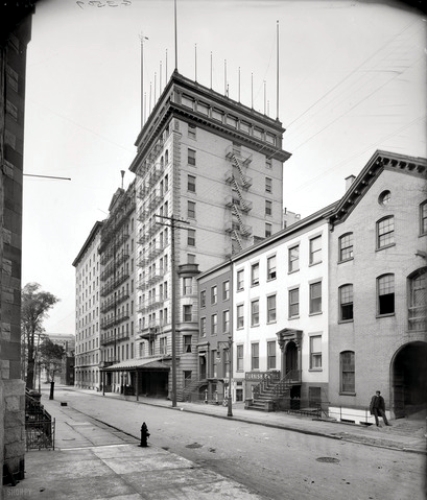Walkabout: Brooklyn’s Hotel St. George, Part 3
Read Part 1, Part 2, Part 4, Part 5, Part 6, and Part 7 of this story. In the early 1890’s, the Hotel St. George’s owner, Captain William Tumbridge, announced that he had hired one of Brooklyn’s most prominent architects, Montrose W. Morris, to design a new wing for the ever-growing hotel. It was the…

Read Part 1, Part 2, Part 4, Part 5, Part 6, and Part 7 of this story.
In the early 1890’s, the Hotel St. George’s owner, Captain William Tumbridge, announced that he had hired one of Brooklyn’s most prominent architects, Montrose W. Morris, to design a new wing for the ever-growing hotel.
It was the perfect match. Both men were a bit larger than life, especially in the ego and self-promotion departments, and Morris’ reputation for expertise in designing high end luxury accommodations was well-deserved, as was the St. George’s reputation as Brooklyn’s finest hotel.
What could be better? Tumbridge held a press conference at which he stated, “The Hotel St. George now compares favorably with some of the best hotels in the world, but we are going to enlarge the building on the Clark St. side…We are going to have a magnificent entrance, 50 feet wide by 160 feet in depth. It will be decorated by Tiffany & Co, and the desk will be enclosed by cathedral glass of a unique design.
Every modern convenience will be introduced in the hotel, and there will be bowling alleys, shuffleboard, a swimming pool and a Turkish bath attached for the amusement and convenience of guests.
The present office will be converted into a smoking room, Turkish parlors with Oriental decorations of a most attractive character, and tea parlors. The mosaic tiling on the new office floor will have some novel and beautiful patriotic designs commemorating the events in the war with Spain.”
Tumbridge went on to say that the new wing would incorporate new bachelor’s apartments, a fast growing market, and that the hotel would continue to be the first rate family hotel it had always been. He noted that the St. George had been forced to turn away customers during the last winter, due to lack of space, even though the hotel had almost 800 rooms.
The hotel also had huge summer patronage, much of which was from local men who stayed in the city to work, while their families went away for the summer. Rather than be alone in their own homes, these men, Tumbridge said, preferred to summer at the St. George. The new rooms would be able to accommodate them well.
Morris’ new St. George annex was a hit, for both men. It insured Montrose’s reputation as one of Brooklyn’s premiere architects, with a massive famous building that everyone could see and check out, and Tumbridge’s grand hotel flourished the new rooms and new amenities making it more popular than ever.
Of course, along with popularity, come problems. In Part One of our story, we met Captain William Tumbridge, and saw how his fascinating life story led him to the St. George. In Part Two, we saw how the good Captain never lost the fighting spirit that had propelled him to success. He gave as good as he got, both in the courtroom, and in an occasional brawl. As the years went by, this did not change.
Like any large hotel with a transient and semi-permanent population, guests and staff included, the Hotel St. George had a story in every room. I could do “Tales of the St. George” from just the 1890s alone, and have material for quite a while. Many of these tales would involve being tossed out of the hotel by Captain Tumbridge himself.
He demanded only a few things from his guests – Pay for your room, conduct yourself with decorum, don’t complain about everything, and pay for your room. There were always those who couldn’t manage to abide by the rules. To them, came the swift and sure judgment of Captain Tumbridge.
The Brooklyn Eagle’s pages are peppered with announcements about Captain Tumbridge tossing people out of the hotel for non-payment. Since this was an expensive and posh place, they were supposedly people of good character and worth. Some of them weren’t. Tumbridge’s lawyers were busy filing suit against this one and that one, all people who must have been embarrassed by having their names in the paper. Some of them sued. Tumbridge tended to win.
In 1892, one of his guests, a man named William Webb, who had lived at the hotel for five years, suddenly packed up and left after an acrimonious meeting with the Captain. According to him, he and his wife and in-laws were having dinner in the dining room, and were served a roasted chicken that was so tough, he broke the knife trying to cut it. Webb said that he politely asked the waiter to get another bird, but the waiter went to Tumbridge instead to complain.
The next day, Webb received a bill from the front desk raising his room and board by $10 a week. When he met with Tumbridge, it turned into a shouting match, and he “fled in alarm” and packed his things. Tumbridge’s side of the story was that Webb always caused a scene in the dining room, and was always complaining about something, and the chicken story was the last straw. He wanted him gone, and figured that raising the rent would do it. He was right.
In October of that year, a clerk named Frank McKeenan, who had been in the hotel’s employ for two years, was up on the roof with others, watching a parade. As they turned to leave, he accidentally stepped on a skylight, which broke under his weight, sending him screaming down a 10 story shaft.
He sustained grave internal injuries and was not expected to live. The paper does not do a follow-up. A month later, a new scandal would take people’s minds away from that tragedy, with a tale as old as time: young love among the corridors of the grand hotel.
Mr. A.A. Eneas was a young and handsome captain of a NYC tugboat, and a boarder at the hotel. Miss Clara Moorse was a beautiful brunette, with no visible means of support, also staying at the hotel, in a room on the same floor. The young captain was seen at odd hours in the hallway, and someone reported this to the room clerk, Mr. Niblo, who told Tumbridge.
Niblo started to watch the young people, and one night it was reported to him that the tugboat captain was in the young lady’s room. Niblo ran to tell Tumbridge, who jumped up, and ran upstairs, taking the stairs two at a time. “This is not THAT kind of hotel”, he was heard to say, and they burst into the woman’s room, and found…well, you can guess. Tumbridge immediately ordered both of them out of the hotel.
The tugboat captain found lodgings elsewhere, but Miss Moorse had nowhere to go, so Tumbridge allowed her to stay the night, under lock and key, in a different room. The next day, she collected her things, paid her bill and vanished from the story.
Captain Eneas, however, was furious. In an interview he insisted there was no impropriety with the young lady, and he barely knew her. He blamed the whole thing on night clerk Niblo, for trying to get him. According to Eneas, Niblo had opened his mail two weeks before, and when Eneas called him on it, Niblo said it was a joke. Hot tempers run in all sea captains’ veins, apparently, because Eneas admitted to going across the counter to get to Niblo, who ran to his boss. Eneas wanted Niblo fired, but Tumbridge refused, and Eneas swore that ever since that time, Niblo was out to ruin him, and this scandal and ejection was the result. He, too, called his lawyers, and filed a $10,000 lawsuit against Tumbridge and the hotel.
Tumbridge’s lawyer was getting rich. In May of 1895, another guest of the hotel, Mr. Ira Morley, a stockbroker, checked into the St. George, stone drunk, something he was wont to do, on occasion.
The next morning, when he went to check out, he stopped at the bar for a pick me up, but had no money to pay his bill. He asked the hotel to call his job, a brokerage on Montague Street, so that someone could send him money.
The bartender did so, and also called Captain Tumbridge, who came out of his office, and, according to Morley, started screaming at him, calling him names, and slapped him and hit him in the face so hard that his nose was bleeding, and he had two black eyes, and his face was so swollen that he wasn’t able to return to work for several days. Needless to say, he called the cops.
At the hearing, Tumbridge’s attorney, Brewster Kissam, got Marley to admit that on the night he checked into the hotel, he had broken a great deal of hotel china in his journey to a good night’s rest. The co-worker at the brokerage, a Mr. Dusseldorf, testified that when he came to the hotel to pay Morley’s bill, Tumbridge attacked Morley for no reason.
When the Captain took the stand, he testified that he had found Morley sprawled on the floor in the corridor, he asked him to move to the billiard room, and left another hotel employee to watch him. When Dusseldorf arrived, Morley got agitated and abusive and started waving his hands in Tumbridge’s face.
The Captain thought Morley was going to hit him, so he hit him first. Unfortunately, the judge called that assault, and fined Captain Tumbridge $25. As expected, Morley announced that he was going to sue.
In February of 1893, Tumbridge fired his chief bellboy, a mixed race young college student known only as “Dobson”. Mr. Dobson was popular with patrons, and was a hero to his fellow bellboys, who numbered fourteen other young black men.
Tumbridge said the firing was because Dobson was not doing his job. He also complained that once a black bellboy had been trained, he left, going to other hotels down south. He didn’t think Dobson was at fault in that, but it was a problem.
Tumbridge announced that he was replacing Dobson with a white man. The entire staff immediately turned in their uniforms, and quit. Porters and other employees had to scramble to fill in. The next day, freshly scrubbed young white faces were learning the ropes, and Tumbridge hoped that they would be even better than the previous bell boys.
You can’t make this stuff up. GMAP
The Hotel St. George saga will continue.

Main photo at top of post: Christmas at the St. George, showing the Tiffany stained glass ceiling in the main lobby.









What's Your Take? Leave a Comment